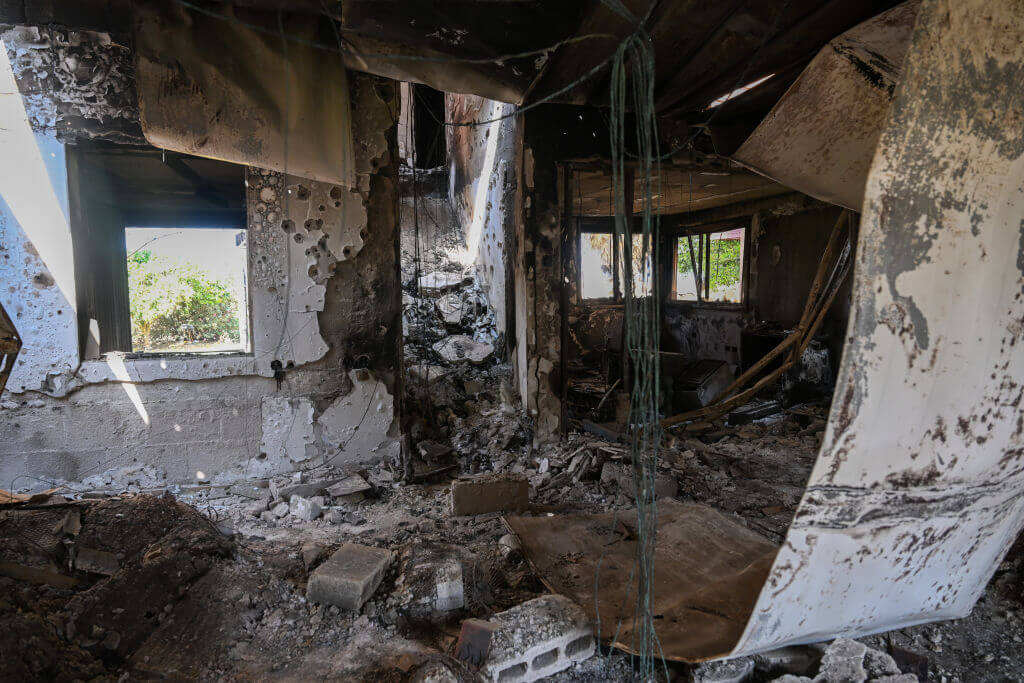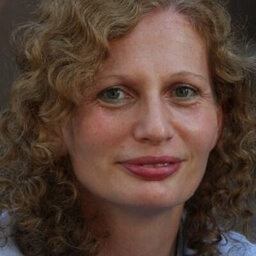News outlets deny watchdog’s allegations that they were tipped to Hamas attacks
Israeli politicians join pro-Israeli group questioning freelancers’ presence at the Gaza border Oct. 7

A destroyed house is seen in the aftermath of Hamas’ Oct. 7 attacks on a kibbutz near the Gaza border. Questions are being raised about images freelance photographers took of the attacks as they unfolded. Photo by Alexi J. Rosenfeld/Getty Images
The Israeli government on Thursday accused Gaza-based photojournalists who freelance for major international news organizations of being complicit in the Oct. 7 Hamas terror attack on southern Israel, echoing the critique of a pro-Israel media watchdog that raised questions about photos taken early in the attack of Hamas fighters breaching the border fence and burning Israeli tanks nearby.
“These journalists were accomplices in crimes against humanity,” said a statement from the prime minister’s office. “Their actions were contrary to professional ethics.”
The news organizations categorically denied any foreknowledge of the attack, thought two of them cut ties with one of the freelancers, who the watchdog said had once posed for a selfie with a Hamas commander.
In addition to the statement from the public diplomacy section of the prime minister’s office, two prominent center-right politicians, Benny Gantz and Yair Lapid, also questioned whether the photographers had been tipped off to the Hamas attack before it happened. Gantz, a former Israeli defense minister, joined Prime Minister Benjamin Netanyahu’s government after the attack and is a member of the war cabinet; Lapid is a former TV journalist who served as prime minister for the second half of 2022.
“Journalists found to have known about the massacre, and still chose to stand as idle bystanders while children were slaughtered, are no different than terrorists and should be treated as such,” Gantz, a former head of the Israel Defense Forces, said on X.
Lapid, leader of Israel’s centrist Yesh Atid party, called on the news organizations to provide more detail about how the photographers managed to capture images of burning Israeli tanks and people being abducted. “The same way the international media is always asking for a response from us — we are now demanding a response from them,” he tweeted. “Who are those journalists? Were they involved in the attack? Did they know in advance? And are you going to fire them?”
Media deny advance knowledge
The accusations and questions stem from a lengthy post Wednesday by the right-wing watchdog, Honest Reporting, which showcased photos by seven freelancers that were taken early on Oct. 7 and published by Reuters and The Associated Press. The freelancers have also worked for The New York Times and CNN.
The AP said in a statement that the first pictures it received were taken more than an hour after the assaults began. Reuters said its first images were made “two hours after Hamas fired rockets across southern Israel and more than 45 minutes after Israel said gunmen had crossed the border.”
“No AP staff were at the border at the time of the attacks, nor did any AP staffer cross the border at any time,” the AP said.
A spokesperson for the Times called the accusations “reckless,” “untrue and outrageous.”
Meanwhile in the lobby of the Times on Thursday, dozens of pro-Palestinians accused the newspaper of biased reporting on the conflict. A woman in a kaffiyeh read the names of Palestinians killed by what she called “apartheid Israel,” with protesters shouting “cease-fire now” after each name. Two demonstrators held a banner that read “New York Crimes” in the paper’s classic font and several held Palestinian flags.
A tweet from BreakThrough News, which describes itself as a news outlet “covering people’s movements and global politics,” described the protesters as “media workers,” though it is unclear who organized the gathering.
The organization behind the accusations
Honest Reporting, which describes itself as a nonprofit “exposing anti-Israel media bias,” is headed by Jacki Alexander, a former regional director for the American Israel Public Affairs Committee, a lobbying group.
Its report, titled “Broken Borders: AP & Reuters Pictures of Hamas Atrocities Raise Ethical Questions,” suggests that Gaza-based photographers were tipped off by Hamas and accompanied terrorists from Gaza into Israel to document the massacres as they unfolded.
Honest Reporting says the “early morning presence at the breached border” of news photographers “raises serious ethical questions. What were they doing there so early on what would ordinarily have been a quiet Saturday morning? Was it coordinated with Hamas?”
Danny Danon, a right-wing Knesset member and Israel’s former United Nations ambassador, piled on Thursday, vowing to hunt the photographers “down together with the terrorists.”
Israel’s official account on X repeated Honest Reporting’s allegations. Jewish Insider reported that Israeli government officials asked the news organizations for explanations.
Along with photographs taken on the morning of the attack, Honest Reporting circulated an image, apparently taken well before Oct. 7, showing one of the photographers, Hassan Eslaiah, posing with Yahya Sinwar, a legendary Hamas leader. That led both CNN and AP to say that they have cut ties with Eslaiah, though CNN said it had no reason “to doubt the journalistic accuracy of the work he has done for us.”
Honest Reporting executive director Gil Hoffman later told the AP that the group had no evidence to back up their insinuations, adding, “we don’t claim to be a news organization.”
In defense of war photography
The Times responded with a “defense of freelance photojournalists working in conflict areas, whose jobs often require them to rush into danger to provide first-hand witness accounts and to document important news.
“This is the essential role of a free press in wartime,” its statement continued. “We are gravely concerned that unsupported accusations and threats to freelancers endangers them and undermines work that serves the public interest.”
The AP echoed this, saying its role is “to gather information on breaking news events around the world, wherever they happen, even when those events are horrific and cause mass casualties.”
Hamas militants murdered 1,400 people in kibbutzim near the Gaza border and at a music festival, and took 240 hostages, including 30 children. The attack started a war in which the Hamas-run health ministry says more than 10,000 people in Gaza have been killed by Israeli airstrikes and ground troops.
The controversy over the role of war photographers brings to mind the arrest of Bilal Hussein, an AP photographer known for his images of the 2004 battle of Fallujah in the Iraq War. The city, an al-Qaeda stronghold, was dangerous for journalists, but Hussein was a native and used his contacts to cover the U.S. attack on the city. His image of insurgents shooting at U.S. soldiers helped AP win a Pulitzer.
Hussein was sent by AP from Fallujah to cover the conflict in the city of Ramadi. He was arrested there in 2006 by U.S. Marines and held for two years without charge. His case became a cause célèbre for the Committee to Protect Journalists and others. The U.S. military released him in 2008 saying he “no longer presented an imperative threat to security.”
















